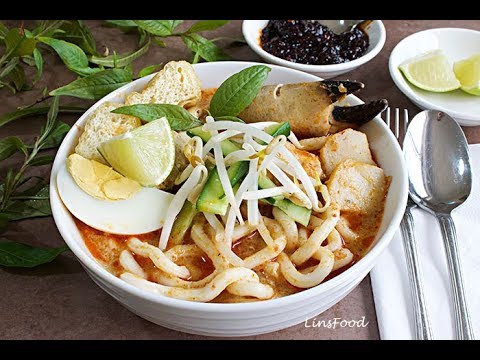This Laksa is a delicious bowl of noodles in a sharp, South East Asian style curry sauce, with sharp and creamy flavours. It epitomises everything I love about the food of the region.
Estimated reading time: 10 minutes
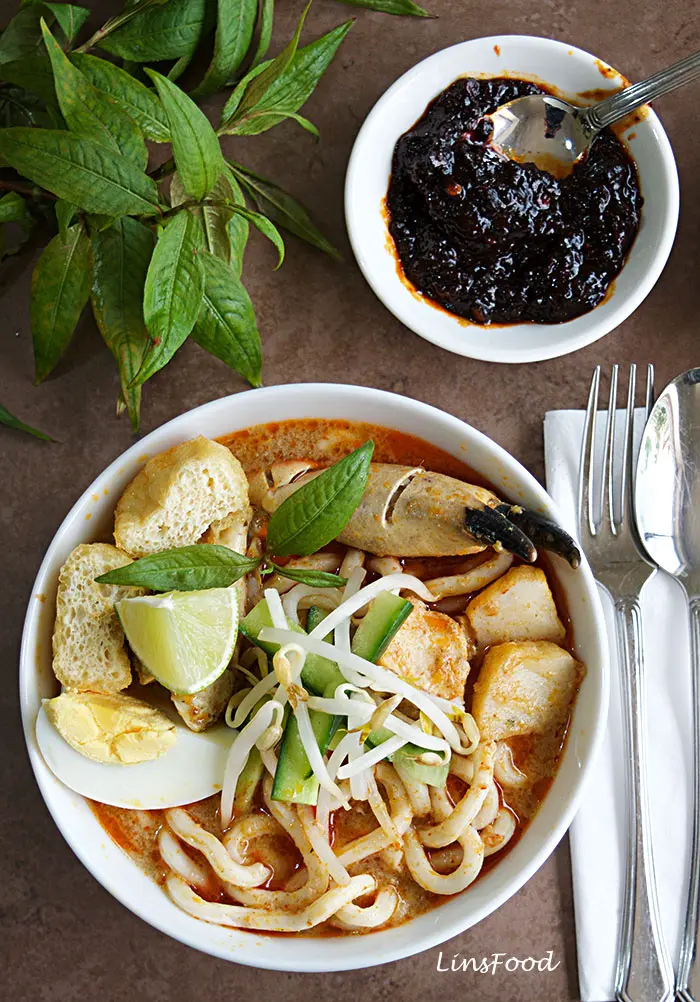
Favourite Childhood Recipe
If you are a Singaporean or Malaysian, chances are, laksa is one of your favourite childhood dishes. Mind you, being Singaporeans and Malaysians, we are rather spoilt for choice. Laksa, to me, has got to be one of the best comfort foods ever – reminds me of my mum, my granny and of everything I love about South East Asian food!
I mention in the Beef Rendang recipe that many of my childhood recipes come courtesy of my granny. But this one, laksa lemak, lies firmly with mum.
As she was a very busy nurse supporting the 5 of us, as well as a recording artist in her early years, she didn’t have a whole lot of time cooking. But still, there are a few dishes that I cook today, that I learnt from her. That’s my mum in the image below, circa 1950s.
ps: if your family has a Malay background, ask the older members if they’ve heard of the late Zainab Majid. That’s mum.

Types of Laksa
There are 2 distinct types of Laksa: Asam Laksa and Laksa Lemak (also known as curry laksa). Each Malaysian state and even Indonesian ones seem to have their own version of either or both. And let’s not forget the Thais, who have their own version of Laksa called Laksam. Every single type of laksa has its own ingredient that distinguishes it from the others. The type of noodles can also be different.
Asam Laksa
This is a hot and sour noodle soup. What distinguishes asam laksa from all the other laksa lemak varieties is the lack of coconut milk and the use of fish.
The word asam (old spelling assam) refers to any souring agent like tamarind. Although the Penang Laksa (Laksa Pulau Pinang in Malay) is the more widely known, in Malaysia, there are also other versions like Perlis Laksa, Kedah Laksa (where my dad’s folks lived) and Ipoh Laksa (where my maternal grandmother was born).
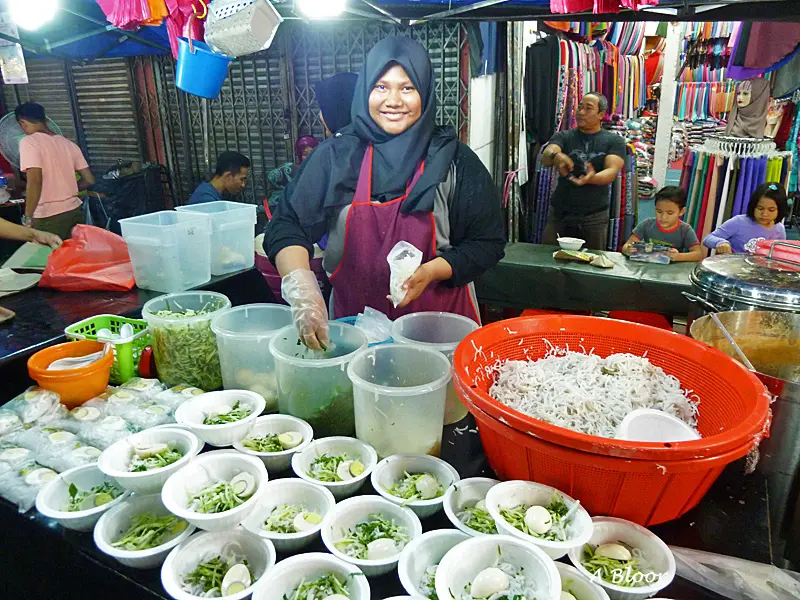
Laksa Lemak
The Malay word lemak, in culinary terms, refers to any dish that has coconut milk in it, like sayur lemak. As far as laksa lemak is concerned, there are many, many different types in Singapore, Malaysia, Indonesia and Thailand.
Some are more curry like in flavour, some lean towards the Red Thai curry flavour, some are a little on the white side in appearance and some are a combination of sour and creamy. You have Laksa Johor, Laksa Sarawak, Nyonya Laksa, Katong Laksa, and the generic Curry Laksa.
Johor = southern most state in Malaysia, connected to Singapore by 2 causeways (crossings) across the water. To Singaporeans, this is just like going over to the next town, albeit with passports. Many of us would just walk across the original one in Woodlands, which was only about 1 km long.
Sarawak = one of 2 East Malaysian states (the other is Sabah), on the island of Borneo. I’ve never been to Sarawak, but I have been to Sabah, the other state, for SCUBA diving, known for its hammerhead dives.
Nyonya = an ethnic group in Singapore and Malaysia. Click here to read more about the various ethnic groups in Singapore and Malaysia.
Katong = a district on the eastern side of Singapore.
Adjectives in the Malay Language
Why do I sometimes use the word laksa at the front and sometimes at the end?
In the Malay language, the adjective comes after the noun. So, laksa from Johor will be Laksa Johor, in Malay, as opposed to Johor Laksa, in English.
Laksa Ingredients
My mum’s laksa is a cross between the Nyonya Laksa and the Johor Laksa. Let’s look at the ingredients we need in making our laksa from scratch, then at our Cheat’s Laksa.
The from-scratch version is another one of those childhood recipes of mine that requires what I have started calling “pesky” ingredients. All my beloved not-easy-to-get South East Asian and Middle Eastern ingredients fall into this category. I suggest you get chummy with online shopping, if you don’t have foot access to shops selling galangal, shrimp paste, et al! But let’s start with the noodles.
Laksa Noodles
The laksa noodles I grew up eating were a special variety, made from rice flour and starch. When I was little, one of my favourite things to do at the local wet market, was to watch the old Chinese lady mixing the dough up and squeezing out the fresh noodles. You cannot get these noodles outside of Singapore and Malaysia.
In my first handful of years here in the UK, the most obvious solution was to use rice vermicelli, and I was quite happy doing that as these thin rice noodles absorb flavours very well. After a while though, I fancied making my own laksa noodles from memory, and after a bit of trial and error, I managed to knock them out. These days, I make up a huge batch and freeze what’s not used for another day.
But we shan’t bother with making our noodles today, just the gravy and all the trimmings! Homemade laksa noodles are on a getting longer by the day list of posts to do – one day!
So what noodles should you use? Any kind of noodles you like, be it rice or wheat. Rice will give you a gluten free recipe.
Galangal

Click here to read more about galangal. I’ve said it before – there is no substitute, upping or substituting with ginger is not the answer; ginger is citrusy and spicy, while galangal is floral and sweet. If you don’t have access to it, you’re better off leaving it out altogether.

Shrimp Paste
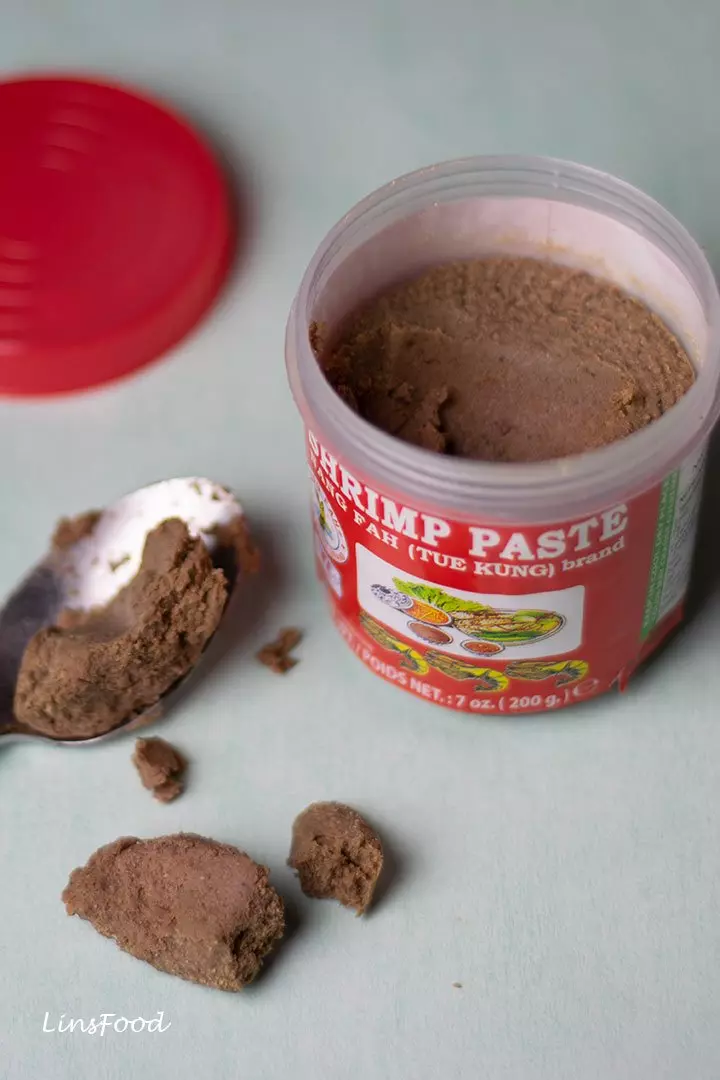
Click here to read more about shrimp paste or belacan. This smelly paste screams umami, and is an indispensable ingredient in South East Asian cooking. If you plan to do any Singaporean, Malaysian,Thai, Indonesian or Vietnamese cooking, then I suggest you source out some shrimp paste. Try Amazon, if there isn’t a store nearby.
Or, if you really can’t find or don’t want shrimp paste, just leave it out. You will still be able to enjoy an aromatic gravy. Or if, by some chance, you can find dried shrimp (see below), use them, just double the amount of the shrimp paste.
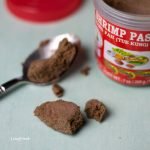
Dried Shrimp
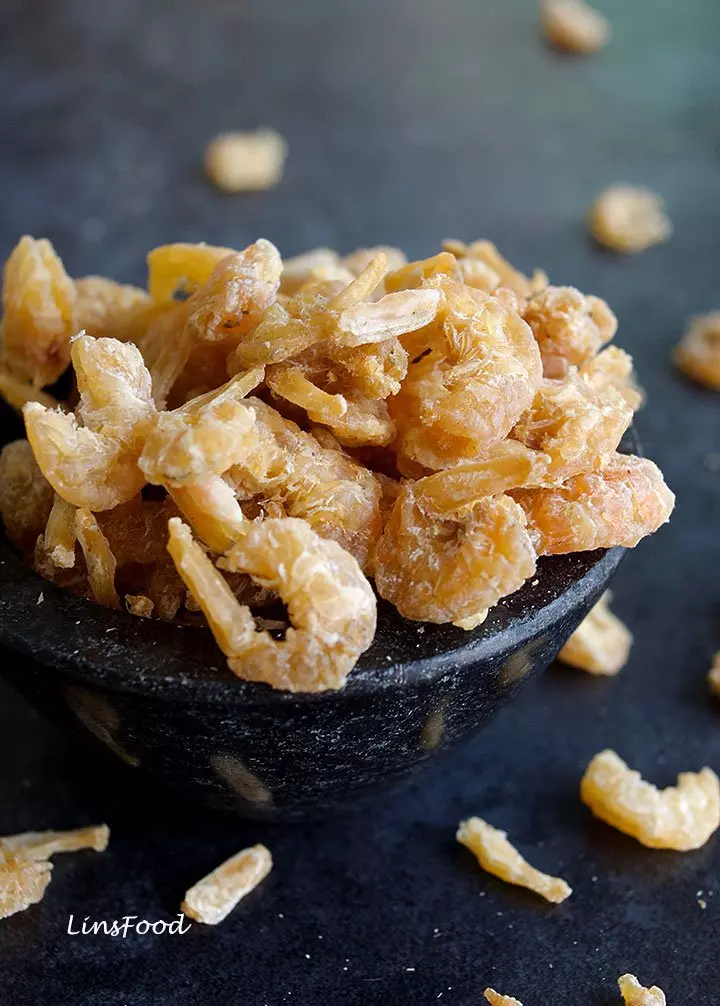
Click here to read more on LinsFood. Air dried shrimp, these smell and taste of the sea and are brimming with umami. Leave them out if you can’t get them or substitute with a handful of shiitake mushrooms for an umami hit. Not strictly the same, but, beggars can’t be choosers. Or use half the shrimp paste (above), if you can get it.

Lemongrass

Click here to read more about lemongrass. I would think that this is pretty easy to come by these days. I wouldn’t bother using dried lemongrass shavings, they smell of dried pieces of wood! But those ready made pastes in jars and tubes? They’re ok, just be sure to get the ones, with as much lemongrass and as little other stuff as possible. Can’t find lemongrass? Just add a tablespoon of lemon juice to the gravy at the end of cooking time.
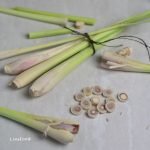
Laksa Herb
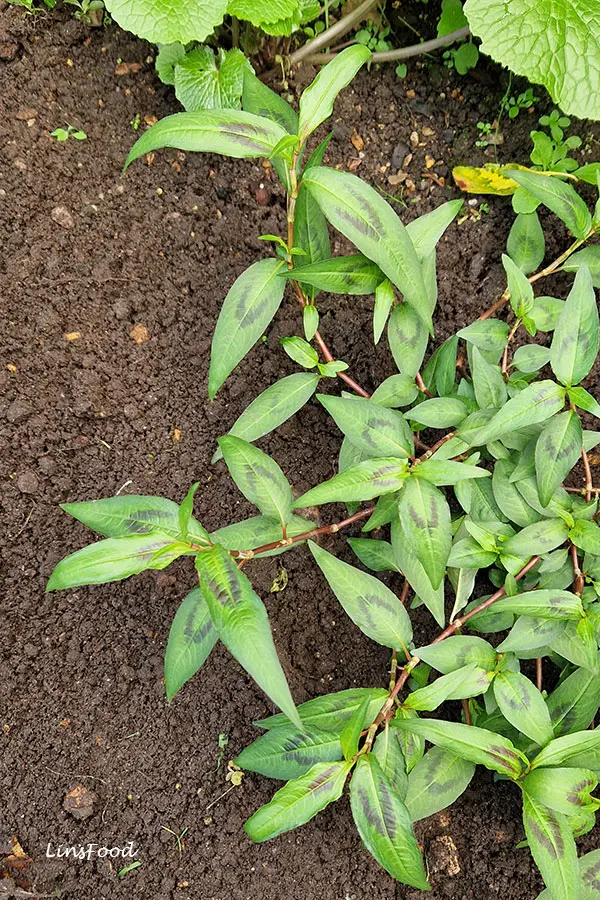
To get the real taste of Laksa the way Singaporeans and Malaysians , we a herb known in the West as Vietnamese Coriander (click to read more) or Vietnamese Mint. Locally, in Singapore and Malaysia, it’s known by its Malay name, Daun Kesum (daun = leaf) and also as laksa leaves. I’ve been growing these leaves for well over 2 decades now, and always have access to some.
Click here to read more and about growing your own laksa leaves.
The alternative to laksa leaves in this recipe is fresh coriander leaves (cilantro). Not a substitute, but an alternative aroma. Just chop some up and sprinkle before serving.
Kaffir lime leaves, if you can get them, can also be used, added in the last 5 minutes of cooking time, for maximum effect.

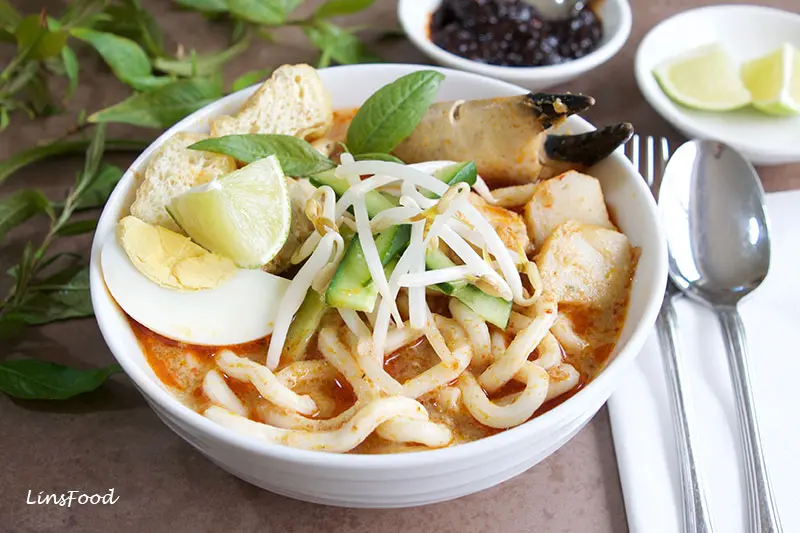
Laksa Toppings
All noodle dishes are served with toppings and garnishes. Here are your standard toppings for today’s noodles but can also be used for others:
- sambal – this will be homemade chilli paste or chilli sauce like this chilli paste recipe (on LinsFood) or even this onion sambal, which is usually used for cooking. You can, however, get shop bought pastes like sambal oelek or even Chinese Chilli Oil.
- wedges of lime, for the juice (lime juice makes all noodle dishes better!)
- boiled eggs (1 per person)
- chopped up herbs like fresh coriander (cilantro)
- fried tofu pieces
- fishballs – the Chinese variety (from, you guessed it, a Chinese grocer) but there’s no reason why you can’t use the more common Thai ones
- Chinese meatballs – click here for easy homemade recipe
- some fresh beansprouts
- a few slices of julienned cucumber
Cheat’s Laksa Recipe
And if you fancy a quicker way, here’s a super easy method. All you need is to get your hands on some Red Thai curry paste, because the ingredients for a Red Thai curry paste and laksa paste are practically the same. Now, for a cheat’s version, we’re not making our homemade laksa paste, instead, we’re going to use some shop bought Red Thai curry paste. So, for this recipe, substitute the paste with:
- 2 heaped tablespoons of shop bought Red Thai curry paste
- 1 tablespoon of ground coriander
Then proceed with the rest of the recipe, leaving out the dried shrimp.
Laksa is a great DIY Party Dish
In Singapore, it is not uncommon to serve this laksa as a party dish. Basically, you place everything on the table: the noodles, the gravy and the toppings. Then you let everyone fill their own bowls.
That’s it. Let’s get cooking!
If you enjoy the recipe, drop me a comment and let me know. Feeling like a star? Don’t forget that 5-star rating!😉
If you make this recipe, post it on Instagram and tag me @azlinbloor and hashtag it #linsfood.
Lin xx
More Noodle Recipes
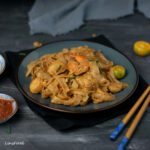
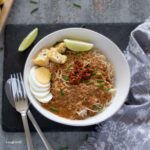
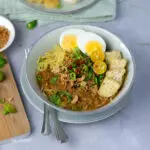
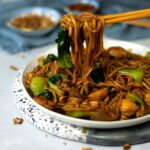
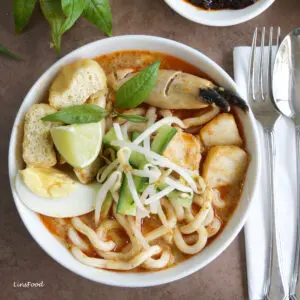
Mum’s Laksa Recipe
Ingredients
- 2 Tbsp vegetable or peanut oil
- 400 ml coconut milk
- 200 ml cup water
- 200 g chicken, cut to bite size pieces
- 200 g prawns (shrimps)
- 600 g fresh rice noodles or dried
- 4 handfuls beansprouts
- Vietnamese coriander (daun kesum) lime leaves or fresh coriander leaves (cilantro)
- 1 tsp salt
- 2 Tbsp dried shrimp soaked in very hot water for 10 minutes
Spice Paste
- 1 large onion
- 2 stalks lemongrass sliced thinly
- 5-10 dried red chillies soaked in very hot water for 10 minutes
- ½ tsp ground turmeric
- 2.5 cm galangal 1 tsp shop bought paste
- 6 candlenuts or macadamia nuts
- 2 tsp shrimp paste toasted
- 2 tsp ground coriander
Garnish
- lime wedges
- fried tofu – just cubes of fresh tofu fried in a little oil for 5 minutes until golden
- slices of fishcake
- 4 boiled eggs halved
- cucumber julienned
- strips of Vietnamese Coriander or real fresh coriander finely chopped
- any sambal or chilli paste
Instructions
- Drain the dried shrimp and either pound in a pestle and mortar or chop in a chopper. In the latter, you’ll end up with a floss like result, which is perfect. If you’re pounding, try and break the shrimps down as much as you can.
- To toast the shrimp paste, watch the video.
- Place all the paste ingredients, starting with the onion and lemongrass in the same unrinsed chopper and chop to get a fairly smooth paste.
- Add each ingredient in the order that it’s listed above. This allows the more fibrous lemongrass and dried chilli to get a longer chopping time.
- I don’t add any water as the moisture from the onion is usually enough but if you find yourself stuck, literally, add a tablespoon or two. When all’s done, set it aside.
- Heat the oil in a heavy based saucepan or deep wok over medium high heat and sauté the paste ingredients for about 2 minutes until you get a wonderful cooked aroma from the paste.
- Lower the heat down and add the pounded shrimp, stirring well for 30 seconds.
- Add the chicken and coat thoroughly.
- Pour in the coconut milk and water and bring to a gentle simmer and cook, uncovered, for 15 minutes. Remember, don’t cook on high heat when using coconut milk.
- Add the prawns, lime leaves and Vietnamese coriander or lime leaves, half a tsp of salt and cook for another 5 minutes. Check seasoning, then turn the heat off.
- We are now going to blanch the noodles and beansprouts separately, then dish up. Bring a large pot of water to a simmer. Add 1 tablespoon of salt.
- If using dried noodles, follow packet instructions to soften, which usually involves soaking them for 15 minutes or so first.
- Have a large Chinese strainer/skimmer at hand or something similar. Place the noodles in the simmering water and cook for just 1 minute and remove. If you don’t have a strainer, just use a sieve and strain the water into another saucepan, as we will be using the same water for the beansprouts. Set the noodles aside.
- Do the same with the beansprouts. You could leave them raw/fresh but just make sure they’re not too cold.
To Serve – Here’s how we eat Laksa!
- Place some noodles in a bowl.
- Top with a handful of beansprouts.
- Ladle some laksa gravy over.
- Top with condiments/garnish of your choice – eggs, fishcakes, herbs, cucumber, etc.
- Squeeze some lime juice all over.
- Top with sambal/chilli paste.
- Then feed your soul!

